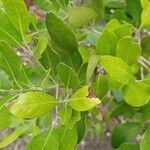Small tree or shrub, up to 8 m high. Leaves petiolate, ± elliptic to obovate, acute to obtuse, shiny, glabrous, dark green above, almost semi-succulent. Domatia on lower leaf surfaces, axils of main and secondary veins. Bacterial nodules round or slightly elongated, along main veins, also scattered over leaf surface. Inflorescences in upper leaf axils; relatively few-flowered clusters in branched corymbs. Flowers: corolla tube up to 10 mm long; lobes 5 mm long. Flowering time Nov.-Feb. Fruit ± 10 mm in diam., black, crowned by 4 small projections of persistent calyx lobes.
Inflorescences lax or somewhat compact, 2.5–6 cm across (excluding corollas); two to four orders of branching present; primary inflorescence branches 2–20 mm long, glabrous; pedicels 4–8 mm long, glabrous; bracts 3–4 mm long, papery, truncate; bracteoles not markedly conspicuous.
Calyx tube 0.6–0.8 mm long, glabrous; limb-tube 0.5–0.6 mm long, slightly wider than tube; lobes 0.5–1.2(2) × 0.5–0.8 mm, usually linear-lanceolate, triangular or narrowly triangular, acute or obtuse, glabrous.
Inflorescence-supporting branches 1.6–8 cm long, slender, bearing 1–5 pairs of leaves clustered near the apex, less often well spaced or rarely all leaves fallen.
Corolla tube 0.6–1.1 cm long, 1–1.25 mm wide at the top, glabrous outside, not bearded at the throat; lobes 5–6 × 2.5–3 mm, ± oblong, acuminate.
Shrub or small tree (1)3–10 m tall; young branches glabrous; older branches with greyish-buff bark.
Fruit black or greyish-green, 6–8 mm in diameter, shiny, the calyx limb persistent.
Seed blackish, 4.5 mm wide, very finely rugulose on convex face.


